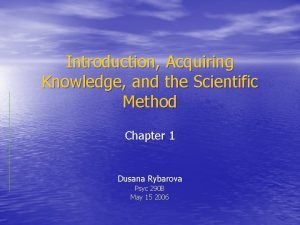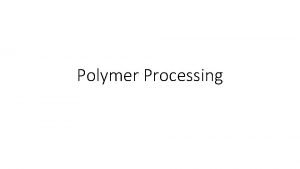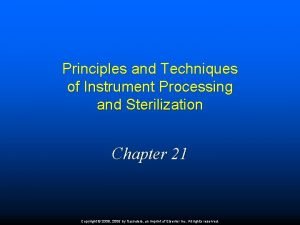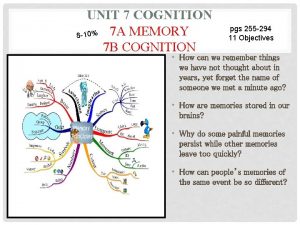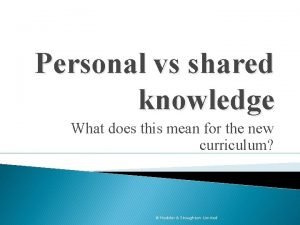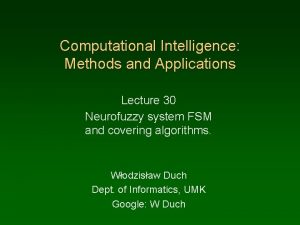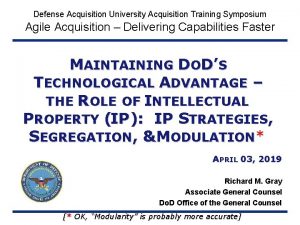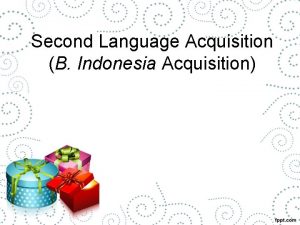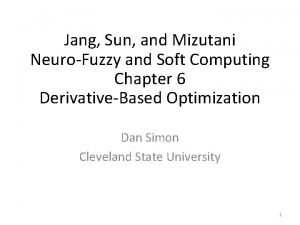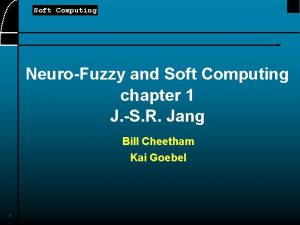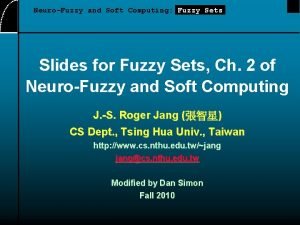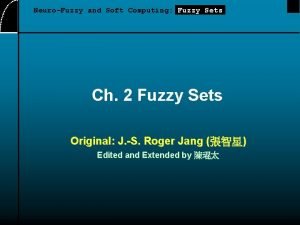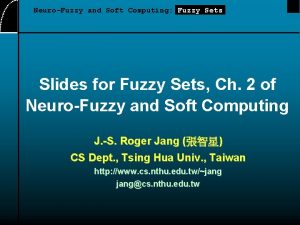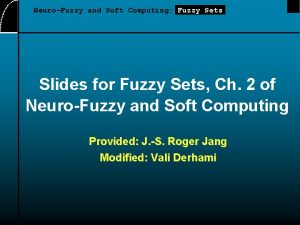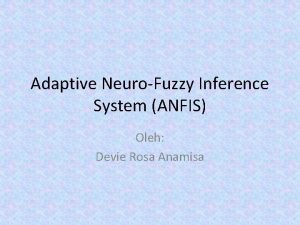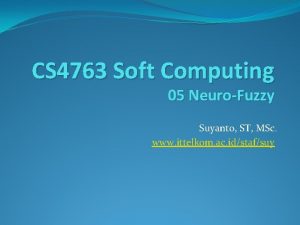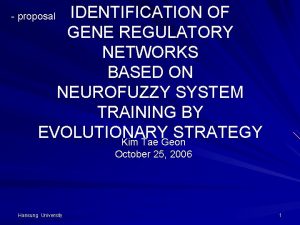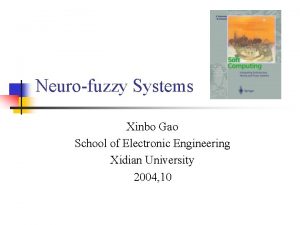Knowledge acquisition and processing new methods for neurofuzzy
























![T-norm A triangular norm T is a function of two arguments T: [0, 1]×[0, T-norm A triangular norm T is a function of two arguments T: [0, 1]×[0,](https://slidetodoc.com/presentation_image/4fc88ab317b9cffbadbc537bc3007184/image-25.jpg)
![T-conorm (S-norm) A T-conorm (S-norm) is a function of two arguments S: [0, 1]×[0, T-conorm (S-norm) A T-conorm (S-norm) is a function of two arguments S: [0, 1]×[0,](https://slidetodoc.com/presentation_image/4fc88ab317b9cffbadbc537bc3007184/image-26.jpg)








![Definition: Fuzzy implication A fuzzy implication is a function I: [0, 1]2→[0, 1] satisfying Definition: Fuzzy implication A fuzzy implication is a function I: [0, 1]2→[0, 1] satisfying](https://slidetodoc.com/presentation_image/4fc88ab317b9cffbadbc537bc3007184/image-35.jpg)






















































- Slides: 89

Knowledge acquisition and processing: new methods for neuro-fuzzy systems Danuta Rutkowska Department of Computer Engineering Technical University of Częstochowa, Poland E-mail: drutko@kik. pcz. czest. pl SOFSEM 2004

Cognitive Technologies Knowledge Acquisition and Inference in the Framework of Soft Computing and Computing with Words SOFSEM 2004

Soft Computing, Computing with Words, . . . • • • Soft computing Computing with words Perception-based systems Computational Intelligence Artificial Intelligence Cognitive sciences Neural networks Fuzzy systems Evolutionary algorithms Intelligent systems

Soft computing techniques

Cognition The word „cognition” cognition comes from the latin word „cognitio”, which means „knowledge”. Cognitive sciences concern thinking, perception, reasoning, creation of meaning, and other functions of a human mind.

Soft computing and cognition The principal aim of soft computing is to exploit the tolerance of uncertainty and vagueness in the area of cognitive reasoning. [Nauck D. , Kruse R. : NEFCLASS-J – A JAVA-Based Soft Computing Tool, In. B. Azvine et al. (Eds. ), Intelligent Systems and Soft Computing, LNAI 1804, Springer-Verlag, Heidelberg, New York (2000), pp. 139 -160].

Artificial Intelligence and cognition The aim of artificial intelligence is to develop paradigms or algorithms that allow machines to perform tasks that involve cognition when performed by humans [A. P. Sage (ed. ), Coincise Encyclopedia of Information Processing in Systems and Organization Pergamon Press, New York, 1990]

Perception and fuzzy systems Perception is very important in human cognition The systems that incorporate perceptions expressed by words are fuzzy systems, introduced by Prof. L. A. Zadeh.

Perception-based systems Fuzzy systems are rule-based systems (knowledge-based systems) that can be viewed as perception-based systems. The rule base of a fuzzy system is composed of fuzzy IF-THEN rules that are similar to the rules used by humans in their reasoning.

Learning by examples is one of the simplest cognitive capabilities of a young child. Artificial neural networks with an inductive, supervised learning algorithm, imitate the cognitive behaviour.

Machine learning research has the potential to make a profound contribution to theory and practice of expert systems, systems as well as to other areas of artificial intelligence Its application to the problem of deriving rule sets from examples is already helping to circumvent the knowledge acquisition bottleneck. [P. Jackson, Introduction to Expert Systems, Addison Wesley, 1999, Chapter 20, p. 399]

Inductive learning The most common form of supervised learning task is called induction. An inductive learning program is one which is capable of learning from examples by a process of generalization. [P. Jackson, Introduction to Expert Systems, Addison Wesley, 1999, Chapter 20, p. 381]

Neural network (MLP)

Model of an artificial neuron

RBF network

Gaussian function

Normalized RBF network

General neuro-fuzzy architecture

Fuzzy reasoning for k-th rule antecedent input variable fuzzification input fuzzy set consequent output variable input value k-th output fuzzy set fuzzy relation

Aggregation and defuzzification aggregation for Mamdani approach output fuzzy set for all N rules S-norm aggregation for logical approach T-norm defuzzification output value centre of consequent fuzzy set Bk

Fuzzy implications: Mamdani, logical Mamdani approach logical approach

An example of a neuro-fuzzy network

More general form of this network

Another example of the NF network
![Tnorm A triangular norm T is a function of two arguments T 0 10 T-norm A triangular norm T is a function of two arguments T: [0, 1]×[0,](https://slidetodoc.com/presentation_image/4fc88ab317b9cffbadbc537bc3007184/image-25.jpg)
T-norm A triangular norm T is a function of two arguments T: [0, 1]×[0, 1]→[0, 1] which satisfies the following conditions for a, b, c, d∈[0, 1]: Monotonicity : T(a, b)≤T(c, d); a≤c; b≤d Commutativity : T(a, b)=T(b, a) Associativity : T (T(a, b), c)=T(a, T(b, c)) Boundary conditions : T(a, 0)=0; T(a, 1)=a
![Tconorm Snorm A Tconorm Snorm is a function of two arguments S 0 10 T-conorm (S-norm) A T-conorm (S-norm) is a function of two arguments S: [0, 1]×[0,](https://slidetodoc.com/presentation_image/4fc88ab317b9cffbadbc537bc3007184/image-26.jpg)
T-conorm (S-norm) A T-conorm (S-norm) is a function of two arguments S: [0, 1]×[0, 1]→[0, 1], which satisfies the following conditions for a, b, c, d∈[0, 1] Monotonicity : S(a, b)≤S(c, d); a≤c; b≤d Commutativity : S(a, b)=S(b, a) Associativity : S (S(a, b), c)=S(a, S(b, c)) Boundary conditions : S(a, 0)=a; S(a, 1)=1

Neuro-fuzzy inference systems (NFIS)

Fuzzy-logic inference system

Fuzzy-logic inference system: fuzzifier

Fuzzy-logic inference system: fuzzy rule base

Fuzzy-logic inference system: fuzzy inference engine

Fuzzy-logic inference system: defuzzifier

General architecture of Neuro-Fuzzy Inference System NFIS

Flexible neuro-fuzzy system: Mamdani approach
![Definition Fuzzy implication A fuzzy implication is a function I 0 120 1 satisfying Definition: Fuzzy implication A fuzzy implication is a function I: [0, 1]2→[0, 1] satisfying](https://slidetodoc.com/presentation_image/4fc88ab317b9cffbadbc537bc3007184/image-35.jpg)
Definition: Fuzzy implication A fuzzy implication is a function I: [0, 1]2→[0, 1] satisfying the following conditions: (I 1) if a 1≤a 3 then I(a 1, a 2)≥I(a 3, a 2), for all a 1, a 2, a 3 [0, 1] (I 2) if a 2≤a 3 then I(a 1, a 2)≤I(a 1, a 3), for all a 1, a 2, a 3 [0, 1] (I 3) I(0, a 2)=1, for all a 2 [0, 1] (falsity implies anything) (I 4) I(a 1, 1)=1, for all a 1 [0, 1] (anything implies tautology) (I 5) I(1, 0)=0 (booleanity)

Fuzzy implications

Flexible neuro-fuzzy system: Logical approach

Flexible neuro-fuzzy system: AND-type compromise NFIS

Flexible neuro-fuzzy system: OR-type compromise NFIS

Flexible neuro-fuzzy system L. Rutkowski and K. Cpałka „Flexible Neuro-Fuzzy Systems”, IEEE Trans. Neural Networks, vol. 14, pp. 554 -574, May 2003

Flexible neuro-fuzzy system: Soft NFIS (1/2)

Flexible neuro-fuzzy system: Soft NFIS (2/2)

Flexible neuro-fuzzy system: NFIS realized by parameterised families of triangular norms (1/2)

Flexible neuro-fuzzy system: NFIS realized by parameterised families of triangular norms (2/2)

Flexible neuro-fuzzy system: NFIS realized by triangular norms with weighted arguments (1/2)

Flexible neuro-fuzzy system: NFIS realized by triangular norms with weighted arguments (2/2)

Flexible neuro-fuzzy system: Glass Identification – experimental results

Flexible neuro-fuzzy system: Glass Identification – weights representation Weights representation in the Glass Identification problem (dark areas correspond to low values and vice versa)

Flexible neuro-fuzzy system: Glass Identification – comparison table

Neuro-fuzzy relational system

Neuro-fuzzy relational system with fuzzy matrix R

Neuro-fuzzy connectionist system (basic architecture)

Rule generation The neuro-fuzzy networks reflect fuzzy IF-THEN rules. The network architectures are created based on the rules. How to get the rules ?

Basic questions: • How many rules ? • What kind of the membership functions (Gaussian, triangular, trapezoidal, etc. ) ? • How to determine parameter values of the membership functions (centers, widths) ?

Many methods There are many methods of rule generation. However, most of the rules obtained by these methods, when applied in neuro-fuzzy systems for classification, result in some misclassifications.

Perception-based approach This method generates fuzzy IF-THEN rules, from a data set, by use of fuzzy granulation. The neuro-fuzzy systems, which utilize these rules, perform without misclassifications.

Multi-stage classification The perception-based approach allows to generate fuzzy rules and perform a multi-stage classification without misclassifications. This method will be illustrated on the IRIS example.

IRIS data set: 150 data items that contain measurements of iris flowers from three species of iris: Setosa, Versicolor, and Virginica; 50 data items for each of the iris species. The data include information about four features of the iris flowers: sepal length, sepal width, petal length, petal width.

Ranges of the measurements of iris flowers (in centimeters) Sepal length 4. 3 – 7. 9 Sepal width 2. 0 – 4. 4 Petal length 1. 0 – 6. 9 Petal width 0. 1 – 2. 5

Ranges within the classes Setosa Versicolor Virginica Sepal 4. 3 – 5. 8 4. 9 – 7. 0 4. 9 – 7. 9 length Sepal 2. 3 – 4. 4 2. 0 – 3. 4 2. 2 – 3. 8 width Petal length 1. 0 – 1. 9 3. 0 – 5. 1 4. 5 – 6. 9 Petal width 0. 1 – 0. 6 1. 0 – 1. 8 1. 4 – 2. 5

Granulated ranges of sepal length 4. 3 – 4. 9 Sestosa 4. 9 – 5. 8 Sestosa Versicolor Virginica 5. 8 – 7. 0 Versicolor Virginica 7. 0 – 7. 9

Granulated ranges of sepal width 2. 0 – 2. 2 Versicolor 2. 2 – 2. 3 Versicolor Virginica 2. 3 – 3. 4 Sestosa Versicolor Virginica Sestosa 3. 4 – 3. 8 – 4. 4

Granulated ranges of petal length 1. 0 – 1. 9 Sestosa 3. 0 – 4. 5 Versicolor 4. 5 – 5. 1 Versicolor Virginica 5. 1 – 6. 9

Granulated ranges of petal width 0. 1 – 0. 6 Sestosa 1. 0 – 1. 4 Versicolor 1. 4 – 1. 8 Versicolor Virginica 1. 8 – 2. 5

Linguistic labels for sepal length 4. 3 – 4. 9 short sepal A 11 4. 9 – 5. 8 medium long sepal A 12 5. 8 – 7. 0 long sepal A 13 7. 0 – 7. 9 very long sepal A 14

Linguistic labels for sepal width 2. 0 – 2. 2 very narrow sepal A 21 2. 2 – 2. 3 narrow sepal A 22 2. 3 – 3. 4 medium wide sepal A 23 3. 4 – 3. 8 wide sepal A 24 3. 8 – 4. 4 very wide sepal A 25

Linguistic labels for petal length 1. 0 – 1. 9 very short petal A 31 3. 0 – 4. 5 medium long petal A 32 4. 5 – 5. 1 long petal A 33 5. 1 – 6. 9 very long petal A 34

Linguistic labels for petal width 0. 1 – 0. 6 very narrow petal A 41 1. 0 – 1. 4 medium wide petal A 42 1. 4 – 1. 8 wide petal A 43 1. 8 – 2. 5 very wide petal A 44

Rule 1 IF sepal is short or medium long and medium wide or very wide and petal is very short and very narrow THEN Setosa IF x 1 is and x 2 is and x 3 is and x 4 is THEN Setosa

Rule 2 IF sepal is medium long or long and very narrow or medium wide and petal is medium long or long and medium wide or wide THEN Versicolor IF x 1 is and x 2 is and x 3 is and x 4 is THEN Versicolor

Rule 3 IF sepal is medium long or very long and narrow or medium wide or wide and petal is long or very long and wide or very wide THEN Virginica IF x 1 is and x 2 is and x 3 is and x 4 is THEN Virginica

NF network for the iris classification

Results of the 1 st stage classification 50 data vectors correctly classified to Setosa 32 data vectors correctly classified to Versicolor 42 data vectors correctly classified to Virginica 26 data vectors – „I do not know” decision: Versicolor or Virginica These data vectors participate in the 2 nd stage of the classification.

2 nd stage classification Two fuzzy IF-THEN rules are formulated, based on the granulated ranges, obtained for the data vectors with the „I do not know” decision in the 1 st stage. The NF network in the 2 nd stage is reduced to the components associated with the Versicolor and Virginica classes.

Results of the 2 nd stage classification 12 data vectors correctly classified to Versicolor 1 data vector correctly classified to Virginica 13 data vectors – „I do not know” decision: Versicolor or Virginica These data vectors participate in the 3 rd stage of the classification. Two new rules are created.

Results of the 3 rd stage classification 4 data vectors correctly classified to Versicolor 5 data vectors correctly classified to Virginica 4 data vectors – „I do not know” decision: Versicolor or Virginica These data vectors participate in the 4 th stage of the classification. Two new rules are created.

Results of the 4 th stage classification 2 data vectors correctly classified to Versicolor 2 data vectors correctly classified to Virginica All data vectors correctly classified after 4 stages of the classification. No misclassifications !

IRIS data: P 1, P 2

IRIS data: P 1, P 3

IRIS data: P 2, P 4

IRIS data: P 3, P 4

Diagnosis of a tumor of mucous membrane of uterus Attributes : • • • period of time after menopause BMI (Body Mass Index) 9 attributes LH (luteinizing hormone ) FSH (follicle-stimulating hormone ) PRL (prolactin ) E 1 (estron) Data: E 2 (estradiol) 52 records of positive diagnosis Aromatase estrogenic receptor Diagnosis: 13 records of negative diagnosis negative (class 0), positive (class 1)

Ranges of the attribute values 0. 5 - 34 20 - 46 0. 5 – 120. 3 1. 36 – 155. 4 2. 4 – 128. 1 156 - 542 0. 04 – 1. 48 2. 28 – 11. 85 0. 72 – 3. 85

Ranges within the classes Class 0 0. 5 - 20 20 - 46 1. 2 – 53. 9 1. 63 – 88. 2 3. 4 – 128. 1 170 - 412 0. 04 – 0. 27 2. 28 – 10. 51 0. 72 – 1. 05 Class 1 0. 5 - 34 20 - 45 0. 5 – 120. 3 1. 36 – 155. 4 2. 4 – 76. 6 156 - 542 0. 05 – 1. 48 3 – 11, 85 0. 91 – 3. 85

Rules for the medical diagnosis

NF network for the medical diagnosis

Results: correct diagnosis 3 cases with the “I do not know” response after the first stage of classification; 62 correct diagnosis for all 65 input vectors. (95. 4% correct decisions, 4. 6 % “I do not know” ) The “I do not know” answers, which mean positive or negative diagnosis, refer to the cases that are difficult to be recognized, because they belong to overlapping regions.

Conclusions (perception-based classification) The perception-based approach allows to generate fuzzy IF-THEN rules in the same way as humans do, and perform the multi-stage classification without misclassifications.

Final conclusions Neuro-fuzzy systems are soft computing methods utilizing artificial neural networks and fuzzy systems. Various connectionist architectures of neuro-fuzzy systems can be constructed. The knowledge acquisition concerns fuzzy IF-THEN rules, and is performed by a learning process. The systems realize an inference (fuzzy reasoning) based on these rules.
 Language acquisition vs language learning
Language acquisition vs language learning What are the market forms and cuts of meat
What are the market forms and cuts of meat Knowledge creation and knowledge architecture
Knowledge creation and knowledge architecture Direct wax pattern technique
Direct wax pattern technique Point processing and neighbourhood processing
Point processing and neighbourhood processing Primary processing of wheat
Primary processing of wheat Interactive processing
Interactive processing Ways of acquiring knowledge
Ways of acquiring knowledge Classification of polymer
Classification of polymer Sterilization techniques
Sterilization techniques What effortful processing methods aid in forming memories?
What effortful processing methods aid in forming memories? Personal and shared knowledge
Personal and shared knowledge Knowledge shared is knowledge squared meaning
Knowledge shared is knowledge squared meaning Knowledge shared is knowledge multiplied meaning
Knowledge shared is knowledge multiplied meaning Contoh shallow knowledge dan deep knowledge
Contoh shallow knowledge dan deep knowledge A priori knowledge
A priori knowledge Book smart vs street smart
Book smart vs street smart Shared knowledge vs personal knowledge
Shared knowledge vs personal knowledge Gertler econ
Gertler econ New knowledge attitudes and skills acquired in ojt
New knowledge attitudes and skills acquired in ojt Bottom-up processing example
Bottom-up processing example Gloria suarez
Gloria suarez Bottom up processing example
Bottom up processing example Point processing
Point processing Histogram processing in digital image processing
Histogram processing in digital image processing Parallel processing vs concurrent processing
Parallel processing vs concurrent processing Laplacian filter
Laplacian filter پردازش تصویر
پردازش تصویر Morphological dilation
Morphological dilation Bottom up vs top down psychology
Bottom up vs top down psychology Kendall and marzano new taxonomy example
Kendall and marzano new taxonomy example Fspos
Fspos Typiska novell drag
Typiska novell drag Tack för att ni lyssnade bild
Tack för att ni lyssnade bild Returpilarna
Returpilarna Varför kallas perioden 1918-1939 för mellankrigstiden
Varför kallas perioden 1918-1939 för mellankrigstiden En lathund för arbete med kontinuitetshantering
En lathund för arbete med kontinuitetshantering Underlag för särskild löneskatt på pensionskostnader
Underlag för särskild löneskatt på pensionskostnader Vilotidsbok
Vilotidsbok A gastrica
A gastrica Vad är densitet
Vad är densitet Datorkunskap för nybörjare
Datorkunskap för nybörjare Boverket ka
Boverket ka Mall för debattartikel
Mall för debattartikel För och nackdelar med firo
För och nackdelar med firo Nyckelkompetenser för livslångt lärande
Nyckelkompetenser för livslångt lärande Påbyggnader för flakfordon
Påbyggnader för flakfordon Lufttryck formel
Lufttryck formel Publik sektor
Publik sektor Urban torhamn
Urban torhamn Presentera för publik crossboss
Presentera för publik crossboss Argument för teckenspråk som minoritetsspråk
Argument för teckenspråk som minoritetsspråk Bat mitza
Bat mitza Treserva lathund
Treserva lathund Fimbrietratt
Fimbrietratt Claes martinsson
Claes martinsson Centrum för kunskap och säkerhet
Centrum för kunskap och säkerhet Byggprocessen steg för steg
Byggprocessen steg för steg Mat för idrottare
Mat för idrottare Verktyg för automatisering av utbetalningar
Verktyg för automatisering av utbetalningar Rutin för avvikelsehantering
Rutin för avvikelsehantering Smärtskolan kunskap för livet
Smärtskolan kunskap för livet Ministerstyre för och nackdelar
Ministerstyre för och nackdelar Tack för att ni har lyssnat
Tack för att ni har lyssnat Referatmarkeringar
Referatmarkeringar Redogör för vad psykologi är
Redogör för vad psykologi är Borstål, egenskaper
Borstål, egenskaper Atmosfr
Atmosfr Borra hål för knoppar
Borra hål för knoppar Vilken grundregel finns det för tronföljden i sverige?
Vilken grundregel finns det för tronföljden i sverige? Variansen formel
Variansen formel Tack för att ni har lyssnat
Tack för att ni har lyssnat Rita perspektiv
Rita perspektiv Verksamhetsanalys exempel
Verksamhetsanalys exempel Tobinskatten för och nackdelar
Tobinskatten för och nackdelar Blomman för dagen drog
Blomman för dagen drog Mästar lärling modellen
Mästar lärling modellen Egg för emanuel
Egg för emanuel Elektronik för barn
Elektronik för barn Plagg i rom
Plagg i rom Strategi för svensk viltförvaltning
Strategi för svensk viltförvaltning Kung som dog 1611
Kung som dog 1611 Indikation för kejsarsnitt på moderns önskan
Indikation för kejsarsnitt på moderns önskan Romarriket tidslinje
Romarriket tidslinje Tack för att ni lyssnade
Tack för att ni lyssnade Multiplikation med uppställning
Multiplikation med uppställning Olika rim dikter
Olika rim dikter Inköpsprocessen steg för steg
Inköpsprocessen steg för steg Fuktmätningar i betong enlig rbk
Fuktmätningar i betong enlig rbk Etik och ledarskap etisk kod för chefer
Etik och ledarskap etisk kod för chefer







